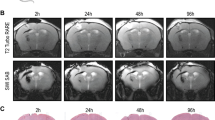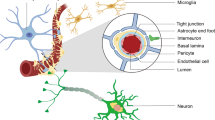Abstract
Intracerebral hemorrhage (ICH) imposes a significant burden on patients, and the volume of hematoma plays a crucial role in determining the severity and prognosis of ICH. Although significant recent progress has been made in understanding the cellular and molecular mechanisms of surrounding brain tissue in ICH, our current knowledge regarding the precise impact of hematoma volumes on neural circuit damage remains limited. Here, using a viral tracing technique in a mouse model of striatum ICH, two distinct patterns of injury response were observed in upstream connectivity, characterized by both linear and nonlinear trends in specific brain areas. Notably, even low-volume hematomas had a substantial impact on downstream connectivity. Neurons in the striatum-ICH region exhibited heightened excitability, evidenced by electrophysiological measurements and changes in metabolic markers. Furthermore, a strong linear relationship (R2 = 0.91) was observed between hematoma volumes and NFL damage, suggesting a novel biochemical index for evaluating changes in neural injury. RNA sequencing analysis revealed the activation of the MAPK signaling pathway following hematoma, and the addition of MAPK inhibitor revealed a decrease in neuronal circuit damage, leading to alleviation of motor dysfunction in mice. Taken together, our study highlights the crucial role of hematoma size as a determinant of circuit injury in ICH. These findings have important implications for clinical evaluations and treatment strategies, offering opportunities for precise therapeutic approaches to mitigate the detrimental effects of ICH and improve patient outcomes.
Graphical Abstract








Similar content being viewed by others
Data Availability
All data generated in this study are provided in the Supplementary Information and Source Data file. Source data are provided in this paper. The codes supporting the current study have not been deposited in a public repository, but are available from the corresponding author upon request.
References
Rosand J. Preserving brain health after intracerebral haemorrhage. Lancet Neurol. 2021;20(11):879–80. https://doi.org/10.1016/S1474-4422(21)00339-2.
Xue M, Yong VW. Neuroinflammation in intracerebral haemorrhage: immunotherapies with potential for translation. Lancet Neurol. 2020;19(12):1023–32. https://doi.org/10.1016/S1474-4422(20)30364-1.
Collaborators GBDS. Global, regional, and national burden of stroke and its risk factors, 1990–2019: a systematic analysis for the Global Burden of Disease Study 2019. Lancet Neurol. 2021;20(10):795–820. https://doi.org/10.1016/S1474-4422(21)00252-0.
LoPresti MA, Bruce SS, Camacho E, Kunchala S, Dubois BG, Bruce E, et al. Hematoma volume as the major determinant of outcomes after intracerebral hemorrhage. J Neurol Sci. 2014;345(1–2):3–7. https://doi.org/10.1016/j.jns.2014.06.057.
Mayer SA. Intracerebral hemorrhage: natural history and rationale of ultra-early hemostatic therapy. Intensive Care Med. 2002;28(Suppl 2):S235–40. https://doi.org/10.1007/s00134-002-1470-8.
Morotti A, Boulouis G, Dowlatshahi D, Li Q, Shamy M, Salman RA, et al. Intracerebral haemorrhage expansion: definitions, predictors, and prevention. Lancet Neurol. 2023;22(2):159–71. https://doi.org/10.1016/S1474-4422(22)00338-6.
Wu CH, Chen CC, Lai CY, Hung TH, Lin CC, Chao M, et al. Treatment with TO901317, a synthetic liver X receptor agonist, reduces brain damage and attenuates neuroinflammation in experimental intracerebral hemorrhage. J Neuroinflammation. 2016;13(1):62. https://doi.org/10.1186/s12974-016-0524-8.
Zhou Y, Wang Y, Wang J, Anne Stetler R, Yang QW. Inflammation in intracerebral hemorrhage: from mechanisms to clinical translation. Prog Neurobiol. 2014;115:25–44. https://doi.org/10.1016/j.pneurobio.2013.11.003.
Zheng Y, Hu Q, Manaenko A, Zhang Y, Peng Y, Xu L, et al. 17beta-Estradiol attenuates hematoma expansion through estrogen receptor alpha/silent information regulator 1/nuclear factor-kappa b pathway in hyperglycemic intracerebral hemorrhage mice. Stroke. 2015;46(2):485–91. https://doi.org/10.1161/STROKEAHA.114.006372.
de Schotten TM, Forkel SJ. The emergent properties of the connected brain. Science. 2022;378(6619):505–10. https://doi.org/10.1126/science.abq2591.
Leergaard TB, Bjaalie JG. Atlas-based data integration for mapping the connections and architecture of the brain. Science. 2022;378(6619):488–92. https://doi.org/10.1126/science.abq2594.
Axer M, Amunts K. Scale matters: the nested human connectome. Science. 2022;378(6619):500–4. https://doi.org/10.1126/science.abq2599.
Lee JH, Liu Q, Dadgar-Kiani E. Solving brain circuit function and dysfunction with computational modeling and optogenetic fMRI. Science. 2022;378(6619):493–9. https://doi.org/10.1126/science.abq3868.
Pasquereau B, DeLong MR, Turner RS. Primary motor cortex of the parkinsonian monkey: altered encoding of active movement. Brain. 2016;139(Pt 1):127–43. https://doi.org/10.1093/brain/awv312.
Gerfen CR. The neostriatal mosaic: compartmentalization of corticostriatal input and striatonigral output systems. Nature. 1984;311(5985):461–4. https://doi.org/10.1038/311461a0.
Huang T, Lin SH, Malewicz NM, Zhang Y, Zhang Y, Goulding M, et al. Identifying the pathways required for coping behaviours associated with sustained pain. Nature. 2019;565(7737):86–90. https://doi.org/10.1038/s41586-018-0793-8.
Zhu X, Tang HD, Dong WY, Kang F, Liu A, Mao Y, et al. Distinct thalamocortical circuits underlie allodynia induced by tissue injury and by depression-like states. Nat Neurosci. 2021;24(4):542–53. https://doi.org/10.1038/s41593-021-00811-x.
Lee JY, Jun H, Soma S, Nakazono T, Shiraiwa K, Dasgupta A, et al. Dopamine facilitates associative memory encoding in the entorhinal cortex. Nature. 2021;598(7880):321–6. https://doi.org/10.1038/s41586-021-03948-8.
Allsop SA, Wichmann R, Mills F, Burgos-Robles A, Chang CJ, Felix-Ortiz AC, et al. Corticoamygdala transfer of socially derived information gates observational learning. Cell. 2018;173(6):1329-42e18. https://doi.org/10.1016/j.cell.2018.04.004.
Benkert P, Meier S, Schaedelin S, Manouchehrinia A, Yaldizli O, Maceski A, et al. Serum neurofilament light chain for individual prognostication of disease activity in people with multiple sclerosis: a retrospective modelling and validation study. Lancet Neurol. 2022;21(3):246–57. https://doi.org/10.1016/S1474-4422(22)00009-6.
Preische O, Schultz SA, Apel A, Kuhle J, Kaeser SA, Barro C, et al. Serum neurofilament dynamics predicts neurodegeneration and clinical progression in presymptomatic Alzheimer’s disease. Nat Med. 2019;25(2):277–83. https://doi.org/10.1038/s41591-018-0304-3.
Gafson AR, Barthelemy NR, Bomont P, Carare RO, Durham HD, Julien JP, et al. Neurofilaments: neurobiological foundations for biomarker applications. Brain. 2020;143(7):1975–98. https://doi.org/10.1093/brain/awaa098.
Sellebjerg F, Magyari M. The prognostic value of neurofilament light chain in serum. Lancet Neurol. 2022;21(3):207–8. https://doi.org/10.1016/S1474-4422(22)00034-5.
Carmona-Iragui M, Alcolea D, Barroeta I, Videla L, Munoz L, Van Pelt KL, et al. Diagnostic and prognostic performance and longitudinal changes in plasma neurofilament light chain concentrations in adults with Down syndrome: a cohort study. Lancet Neurol. 2021;20(8):605–14. https://doi.org/10.1016/S1474-4422(21)00129-0.
Hviid CVB, Gyldenholm T, Lauridsen SV, Hjort N, Hvas AM, Parkner T. Plasma neurofilament light chain is associated with mortality after spontaneous intracerebral hemorrhage. Clin Chem Lab Med. 2020;58(2):261–7. https://doi.org/10.1515/cclm-2019-0532.
Xu J, Chen Z, Yu F, Liu H, Ma C, Xie D, et al. IL-4/STAT6 signaling facilitates innate hematoma resolution and neurological recovery after hemorrhagic stroke in mice. Proc Natl Acad Sci U S A. 2020;117(51):32679–90. https://doi.org/10.1073/pnas.2018497117.
Reiners JJ Jr, Lee JY, Clift RE, Dudley DT, Myrand SP. PD98059 is an equipotent antagonist of the aryl hydrocarbon receptor and inhibitor of mitogen-activated protein kinase kinase. Mol Pharmacol. 1998;53(3):438–45. https://doi.org/10.1124/mol.53.3.438.
Alessi DR, Cuenda A, Cohen P, Dudley DT, Saltiel AR. PD 098059 is a specific inhibitor of the activation of mitogen-activated protein kinase kinase in vitro and in vivo. J Biol Chem. 1995;270(46):27489–94. https://doi.org/10.1074/jbc.270.46.27489.
Luo J, Xue D, Song F, Liu X, Li W, Wang Y. DUSP5 (dual-specificity protein phosphatase 5) suppresses BCG-induced autophagy via ERK 1/2 signaling pathway. Mol Immunol. 2020;126:101–9. https://doi.org/10.1016/j.molimm.2020.07.019.
Kreitzer AC, Malenka RC. Striatal plasticity and basal ganglia circuit function. Neuron. 2008;60(4):543–54. https://doi.org/10.1016/j.neuron.2008.11.005.
Gerfen CR, Engber TM, Mahan LC, Susel Z, Chase TN, Monsma FJ Jr, et al. D1 and D2 dopamine receptor-regulated gene expression of striatonigral and striatopallidal neurons. Science. 1990;250(4986):1429–32. https://doi.org/10.1126/science.2147780.
Abu-Rumeileh S, Abdelhak A, Foschi M, D’Anna L, Russo M, Steinacker P, et al. The multifaceted role of neurofilament light chain protein in non-primary neurological diseases. Brain. 2023;146(2):421–37. https://doi.org/10.1093/brain/awac328.
Bircak-Kuchtova B, Chung HY, Wickel J, Ehler J, Geis C. Neurofilament light chains to assess sepsis-associated encephalopathy: are we on the track toward clinical implementation? Crit Care. 2023;27(1):214. https://doi.org/10.1186/s13054-023-04497-4.
Coleman MP, Hoke A. Programmed axon degeneration: from mouse to mechanism to medicine. Nat Rev Neurosci. 2020;21(4):183–96. https://doi.org/10.1038/s41583-020-0269-3.
Balami JS, Chen RL, Grunwald IQ, Buchan AM. Neurological complications of acute ischaemic stroke. Lancet Neurol. 2011;10(4):357–71. https://doi.org/10.1016/S1474-4422(10)70313-6.
Summers DW, Milbrandt J, DiAntonio A. Palmitoylation enables MAPK-dependent proteostasis of axon survival factors. Proc Natl Acad Sci U S A. 2018;115(37):E8746–54. https://doi.org/10.1073/pnas.1806933115.
Walker LJ, Summers DW, Sasaki Y, Brace EJ, Milbrandt J, DiAntonio A. MAPK signaling promotes axonal degeneration by speeding the turnover of the axonal maintenance factor NMNAT2. Elife. 2017;6:e22540. https://doi.org/10.7554/eLife.22540
Puy L, Parry-Jones AR, Sandset EC, Dowlatshahi D, Ziai W, Cordonnier C. Intracerebral haemorrhage. Nat Rev Dis Primers. 2023;9(1):14. https://doi.org/10.1038/s41572-023-00424-7.
Li X, Gao X, Zhang W, Liu M, Han Z, Li M, et al. Microglial replacement in the aged brain restricts neuroinflammation following intracerebral hemorrhage. Cell Death Dis. 2022;13(1):33. https://doi.org/10.1038/s41419-021-04424-x.
Sun Q, Xu X, Wang T, Xu Z, Lu X, Li X, et al. Neurovascular units and neural-glia networks in intracerebral hemorrhage: from mechanisms to translation. Transl Stroke Res. 2021;12(3):447–60. https://doi.org/10.1007/s12975-021-00897-2.
Dolphin AC, Lee A. Presynaptic calcium channels: specialized control of synaptic neurotransmitter release. Nat Rev Neurosci. 2020;21(4):213–29. https://doi.org/10.1038/s41583-020-0278-2.
Rusakov DA. Disentangling calcium-driven astrocyte physiology. Nat Rev Neurosci. 2015;16(4):226–33. https://doi.org/10.1038/nrn3878.
Shi K, Tian DC, Li ZG, Ducruet AF, Lawton MT, Shi FD. Global brain inflammation in stroke. Lancet Neurol. 2019;18(11):1058–66. https://doi.org/10.1016/S1474-4422(19)30078-X.
Cheng Y, Zhang G, Li G. Targeting MAPK pathway in melanoma therapy. Cancer Metastasis Rev. 2013;32(3–4):567–84. https://doi.org/10.1007/s10555-013-9433-9.
Zille M, Farr TD, Keep RF, Romer C, Xi G, Boltze J. Novel targets, treatments, and advanced models for intracerebral haemorrhage. EBioMedicine. 2022;76:103880. https://doi.org/10.1016/j.ebiom.2022.103880.
Yu Z, Zhang L, Zhang G, Xia K, Yang Q, Huang T, et al. Lipids, apolipoproteins, statins, and intracerebral hemorrhage: a Mendelian randomization study. Ann Neurol. 2022;92(3):390–9. https://doi.org/10.1002/ana.26426.
Zwagemaker AF, Gouw SC, Jansen JS, Vuong C, Coppens M, Hu Q, et al. Incidence and mortality rates of intracranial hemorrhage in hemophilia: a systematic review and meta-analysis. Blood. 2021;138(26):2853–73. https://doi.org/10.1182/blood.2021011849.
Vanent KN, Leasure AC, Acosta JN, Kuohn LR, Woo D, Murthy SB, et al. Association of chronic kidney disease with risk of intracerebral hemorrhage. JAMA Neurol. 2022;79(9):911–8. https://doi.org/10.1001/jamaneurol.2022.2299.
Funding
This work is supported by the National Natural Science Foundation of China 12372303, Venture & Innovation Support Program for Chongqing Overseas Returnees cx2020079, and Scientific and Fundamental Research Funds for the Central Universities (2023CDJXY-050, 2023CDJXY-051).
Author information
Authors and Affiliations
Contributions
Thank the members: S.H. and Y.W. designed the experiments; Y.W. and Q.D. performed the experiments; R.W., S.C., F.D., H.Y., and N.H. performed the data analysis; S.H. and B.W. inspected the data and evaluated the findings; S.H. and B.W. wrote the manuscript with the help from all authors.
Corresponding authors
Ethics declarations
Ethics Approval and Consent to Participate
All animal experiments followed the guidelines set forth by the NIH Guide for the Care and Use of Laboratory Animals (National Academies Press, 2011) and were approved by the Institutional Animal Care and Use Committee of Chongqing University.
Consent for Publication
All authors have approved the manuscript and agree with its submission.
Competing interests
The authors declare no competing interests.
Additional information
Publisher's Note
Springer Nature remains neutral with regard to jurisdictional claims in published maps and institutional affiliations.
Supplementary Information
Below is the link to the electronic supplementary material.
Rights and permissions
Springer Nature or its licensor (e.g. a society or other partner) holds exclusive rights to this article under a publishing agreement with the author(s) or other rightsholder(s); author self-archiving of the accepted manuscript version of this article is solely governed by the terms of such publishing agreement and applicable law.
About this article
Cite this article
Wu, Y., Deng, Q., Wei, R. et al. Unveiling the Hidden Impact: Hematoma Volumes Unravel Circuit Disruptions in Intracerebral Hemorrhage. Transl. Stroke Res. (2024). https://doi.org/10.1007/s12975-024-01257-6
Received:
Revised:
Accepted:
Published:
DOI: https://doi.org/10.1007/s12975-024-01257-6




